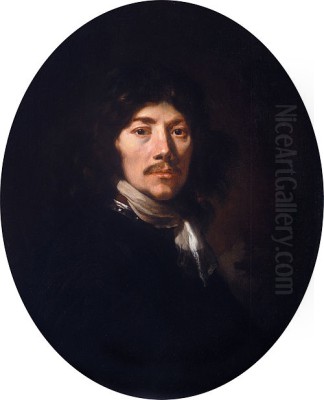
Jacob van Loo stands as a significant, if sometimes overlooked, figure in the rich tapestry of Dutch Golden Age painting. Born in 1614 in Sluis, a town in the Zeeland province of the Netherlands, and passing away in Paris on November 26, 1670, Van Loo’s life and career bridged two of Europe's most vibrant artistic centers: Amsterdam and Paris. He was a versatile artist, renowned for his elegant group paintings, compelling mythological and biblical scenes, and particularly for his sensitive and sophisticated depictions of the female nude, an area where some contemporaries felt he even surpassed the great Rembrandt. His artistic journey, however, was dramatically punctuated by a violent incident that led to his permanent exile from his homeland, a twist of fate that ultimately shaped the latter half of his productive career in France.
Early Life and Artistic Formation
Jacob van Loo was born into a family with artistic inclinations. While details about his earliest training are somewhat scarce, it is believed his father, possibly named Jan van Loo, was either a notary or, more pertinently, a painter himself. This familial connection to the arts likely provided Jacob with his initial exposure and encouragement. Sluis, his birthplace, was a fortified town with a history of trade and conflict, but the burgeoning artistic environment of the Dutch Republic would soon draw him to its cultural heart.
By the 1630s or early 1640s, Van Loo had moved to Amsterdam, the bustling metropolis that was then the epicenter of Dutch commerce, culture, and art. Here, he would have been immersed in a highly competitive and innovative artistic scene, surrounded by masters who were redefining genres and techniques. It is in Amsterdam that Van Loo truly honed his skills and began to establish his reputation. His early works from this period show an assimilation of prevailing Dutch styles, but with a growing personal signature characterized by refined compositions and a subtle, harmonious palette. He likely studied with an unknown master, or perhaps was largely self-taught, absorbing influences from the works of artists active in the city.
Flourishing in Amsterdam
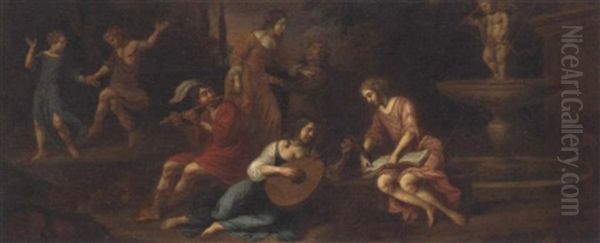
During his Amsterdam years, Jacob van Loo became a respected and sought-after painter. He specialized in various genres, demonstrating remarkable versatility. His group portraits and "conversation pieces" (gezelschapjes) were particularly popular, capturing the convivial spirit and social interactions of the Dutch elite. These works often featured elegant figures in domestic settings or musical parties, rendered with a keen eye for detail and a sophisticated understanding of human interplay. An excellent example of this genre is his Musical Company, now housed in the Thyssen-Bornemisza Museum in Madrid, which showcases his ability to create a lively yet harmonious scene.
Van Loo also excelled in mythological and biblical narratives. His depictions of these subjects were often imbued with a classical sensibility, favoring graceful forms and balanced compositions. He was particularly noted for his skill in painting the nude female figure, treating it with an elegance and naturalism that was highly admired. Works like Diana and Callisto (circa 1650) and various depictions of Bacchus or bacchanalian scenes highlight his mastery in this area. Some art critics of his time, and even later, suggested that his rendering of female flesh and form was more delicate and appealing than that of his contemporary, Rembrandt van Rijn, whose nudes were often more raw and less idealized.
His portraiture was also highly regarded. A notable example is the Portrait of the Countess of Goldstein (1655), which displays his ability to capture not only a likeness but also the sitter's status and personality with refined brushwork and subtle coloration. During this period, he would have been aware of, and likely competed with, other prominent Amsterdam portraitists such as Bartholomeus van der Helst and Govert Flinck. The artistic environment was rich, with figures like Frans Hals revolutionizing portraiture in nearby Haarlem, and the towering presence of Rembrandt casting a long shadow.
In 1642, Van Loo married Anna Lengele in Amsterdam. She was the sister of the painter Martinus Lengele, further cementing his ties within the artistic community. His reputation grew to the extent that he was recommended by the influential poet and secretary to the Prince of Orange, Constantijn Huygens, as one of the artists considered for the prestigious commission to decorate the Oranjezaal in the Huis ten Bosch palace in The Hague, a project that ultimately involved artists like Caesar van Everdingen and Salomon de Bray.
The Turning Point: A Fatal Brawl and Exile
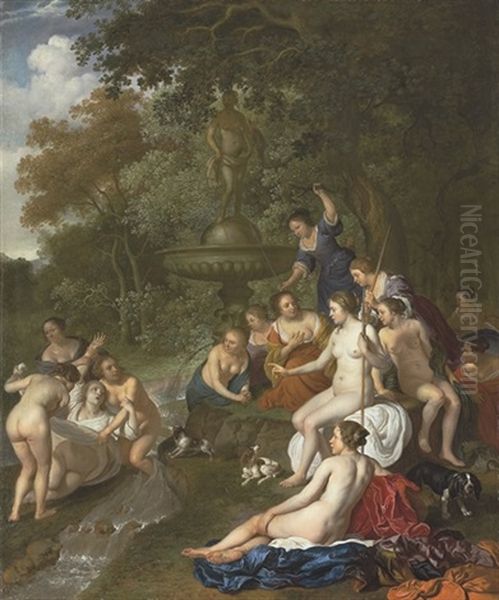
Jacob van Loo's successful career in Amsterdam came to an abrupt and dramatic end in 1660. In a tragic incident, he became involved in a dispute at a tavern or inn. The altercation escalated, and Van Loo fatally stabbed a man named Hendrik Breda. The details of the argument remain obscure, but the consequences were severe. Faced with a charge of manslaughter or murder, and likely a death sentence if caught, Van Loo was forced to flee the Dutch Republic.
He was tried in absentia and condemned, meaning he could never return to his homeland without risking execution. This event marked a profound rupture in his life, forcing him to abandon his established practice, his network of patrons, and his cultural roots in Amsterdam. The promising trajectory of his Dutch career was irrevocably altered, and he sought refuge in Paris, France.
A New Chapter in Paris
Despite the circumstances of his departure from Amsterdam, Jacob van Loo managed to rebuild his career with considerable success in Paris. The French capital, under the burgeoning reign of Louis XIV, was itself a major artistic hub, with a different set of artistic conventions and patronage systems, largely centered around the court and the Académie Royale de Peinture et de Sculpture.
Van Loo quickly integrated into the Parisian art world. His talent was recognized, and in 1662, just two years after his arrival, he was approved (agréé) by the prestigious Académie Royale. He officially became a full member (académicien) in 1663, a significant achievement for a foreign artist, especially one with a troubled past. His reception piece for the Academy was likely a demonstration of his skill in historical or mythological painting, the genres most esteemed by the institution, which was then dominated by figures like Charles Le Brun.
In Paris, Van Loo continued to paint mythological scenes and portraits, adapting his style somewhat to French tastes, which often favored a more pronounced classicism and elegance than the sometimes more robust naturalism of Dutch art. He produced works such as Paris and Oenone, now in the Staatliche Kunstsammlungen Dresden, and continued to be admired for his depictions of the female form. His Portrait of Michel Corneille, a fellow painter and member of the Academy, now in the Louvre, attests to his standing within the Parisian artistic community. He also undertook religious commissions, such as the Baptism of St. Augustine, which found a place in the choir of Notre-Dame Cathedral.
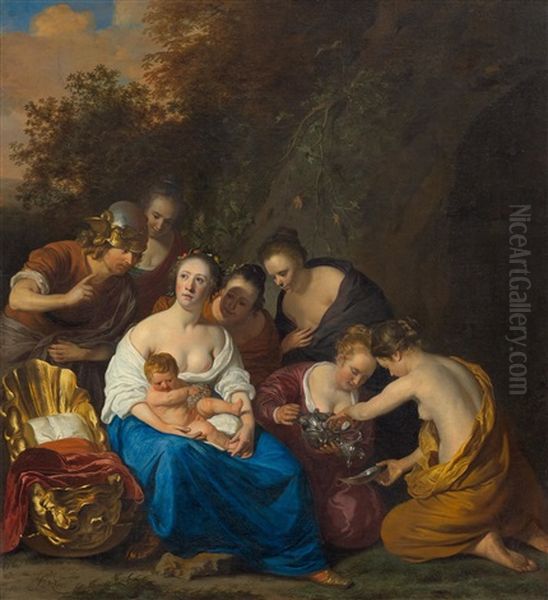
His artistic activities in Paris were not isolated. He would have been aware of the work of French contemporaries such as Eustache Le Sueur and Sébastien Bourdon, and the pervasive influence of Nicolas Poussin, even though Poussin spent much of his career in Rome. Van Loo's ability to thrive in this new environment speaks volumes about his artistic adaptability and the universal appeal of his talent. He remained in Paris until his death on November 26, 1670.
Artistic Style, Themes, and Influences
Jacob van Loo's style is generally characterized as belonging to the Baroque period, with a distinct inclination towards a classical harmony and elegance, particularly in his treatment of the human figure. His Dutch origins are evident in his subtle use of color, his sensitivity to light, and his ability to capture textures and expressions.
Nudes and Mythological Scenes: Van Loo is perhaps best known for his mythological paintings featuring graceful nudes. Works like Diana and Callisto, Danaë, and various bacchanals showcase his mastery of anatomy and his ability to render flesh tones with a soft, luminous quality. His figures are typically idealized, conforming to classical canons of beauty, yet they possess a gentle naturalism. This distinguished him from some contemporaries whose nudes could be more overtly sensual or, in Rembrandt's case, strikingly unidealized. His approach was refined and sophisticated, appealing to a clientele that appreciated both the mythological subject matter and the aesthetic beauty of the forms.
Portraits and Group Paintings: In his portraits, Van Loo demonstrated a keen psychological insight, capturing the personality of his sitters with a dignified yet approachable manner. His group paintings, especially from his Amsterdam period, are notable for their "conversational" quality, where figures interact naturally within a well-composed space. He paid close attention to costume and setting, providing a glimpse into the lives of his affluent patrons.
Biblical Scenes: Van Loo also painted biblical subjects, often choosing dramatic or poignant moments. These works, like his mythological scenes, were characterized by clear storytelling, balanced compositions, and an elegant rendering of figures. A work like Lot and His Daughters (versions of which are attributed to him or his circle, and likely the subject of the "John and his Daughters" mentioned in some sources as being in the Louvre) would fit this category, combining dramatic narrative with the opportunity to depict expressive figures.
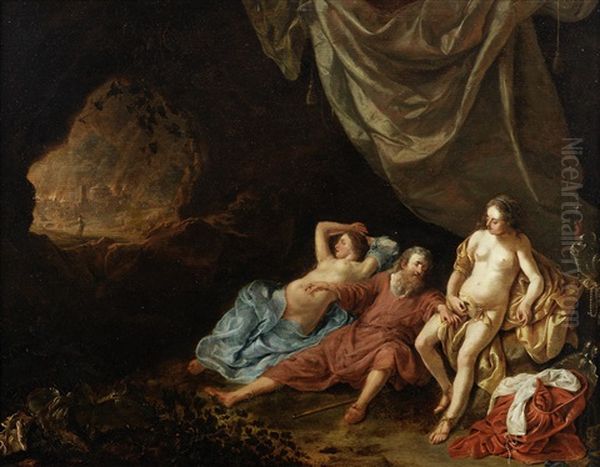
Influence of Contemporaries and on Later Artists: Van Loo was undoubtedly influenced by the artistic currents of his time. In Amsterdam, he would have absorbed lessons from the Utrecht Caravaggisti's use of chiaroscuro, though his own lighting is generally softer. The classicizing tendencies seen in the work of artists like Caesar van Everdingen also find an echo in Van Loo's balanced compositions.
Conversely, Van Loo's work, particularly his refined color harmonies and his treatment of light, is thought to have had an influence on younger Dutch artists, most notably Johannes Vermeer. The clarity and serene elegance of Van Loo's figures, especially his female subjects in interior settings, may have resonated with Vermeer's own artistic preoccupations.
The Van Loo Dynasty
One of Jacob van Loo's most enduring legacies was the establishment of a prominent dynasty of painters. His sons, Jean van Loo (1654-1700) and Louis-Abraham van Loo (c. 1653-1712), both became painters. Louis-Abraham won the Prix de Rome and worked on significant decorative projects.
The family's artistic prominence reached its zenith with Jacob's grandsons. Louis-Michel van Loo (1707-1771) became a highly successful court painter, serving Philip V of Spain and later Louis XV of France. His portraits are iconic representations of European royalty. Other notable grandsons included Jean-Baptiste van Loo (1684-1745), who also enjoyed an international career, working in Italy and England as well as France, and Charles-Amédée-Philippe van Loo (1719-1795), who became court painter to Frederick the Great of Prussia. Carle Van Loo (Charles-André van Loo, 1705-1765), another grandson (son of Louis-Abraham), was one of the most important French painters of the mid-18th century, excelling in various genres and holding high positions in the Académie Royale. This family of artists, originating with Jacob, played a significant role in European art for over a century.
Notable Works and Collections
Jacob van Loo's paintings are held in prestigious museums across the world. Beyond those already mentioned:
The Rijksmuseum in Amsterdam holds works such as Young Man Reading, showcasing his intimate genre scenes.
The Hermitage Museum in St. Petersburg possesses his Musical Gathering, another fine example of his conversation pieces.
The Statens Museum for Kunst in Copenhagen has A Glass and Coral Factory attributed to him, which, if accurate, would represent a more unusual subject matter, perhaps reflecting Dutch interests in trade and industry.
Various French museums, including the Musée des Beaux-Arts in Nice, hold works by him and his descendants, reflecting the family's strong connection to France.
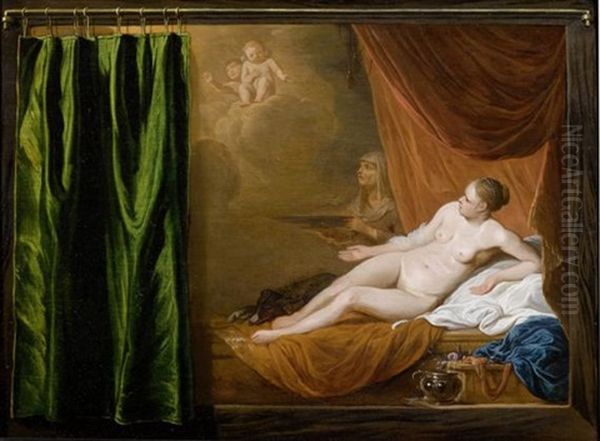
His oeuvre includes works like The Phrygian (an early piece), and numerous other mythological scenes, portraits, and genre paintings that attest to his skill and versatility. The dispersal of his works across Dutch, French, Spanish, Danish, and Russian collections speaks to his international reputation both during his lifetime and subsequently.
Conclusion: An Enduring Legacy
Jacob van Loo was a painter of considerable talent and sophistication, a key figure of the Dutch Golden Age whose career was dramatically bifurcated by personal tragedy and exile. In Amsterdam, he established himself as a master of elegant genre scenes, refined nudes, and insightful portraits, contributing to the rich artistic milieu that included giants like Rembrandt and Vermeer. His forced relocation to Paris did not diminish his artistic output; instead, he successfully navigated the French art world, gaining acceptance into the Académie Royale and continuing to produce high-quality work.
While perhaps not as universally recognized today as some of his Dutch contemporaries, Van Loo's artistic achievements are undeniable. His technical skill, particularly in rendering the human form and in creating harmonious compositions, was exceptional. He was a crucial link in the transmission of artistic ideas between the Netherlands and France, and he founded an artistic dynasty that would leave an indelible mark on European art for generations. His life story, marked by both artistic triumph and personal turmoil, adds a compelling human dimension to his accomplished body of work, securing his place as a noteworthy master of the 17th century.